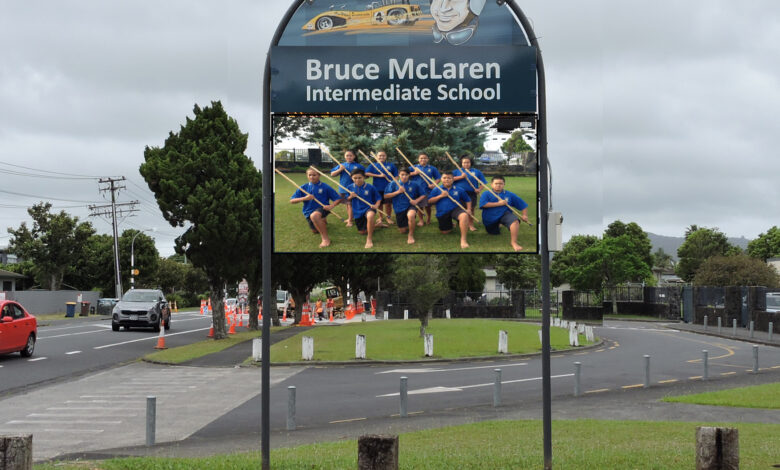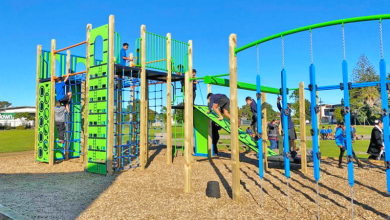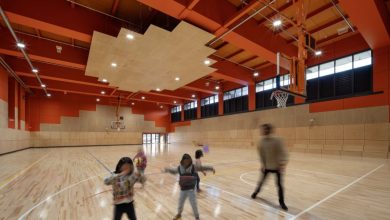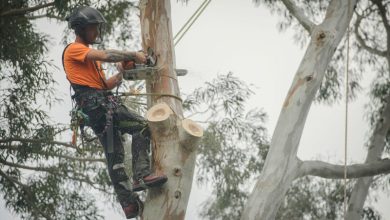Digital signage dos and don’ts

The demand for up-to-date information is constant, and digital signage can play a big part in keeping parents, students, teachers and the broader community informed. Digital signage can be used to share school achievements, warn of closures, promote upcoming events, or simply display the time and date.
Term 3 issue of School News print magazine is available for free here.
In this article, we will be looking at building and entrance signage, digital noticeboards and gymnasium screens. We will also look at how software can assist central programming and key purchasing considerations.
Guidelines and best practice
Digital signage is regulated under three main areas: dwell time (how long each message appears for), luminance (how much light the sign gives off) and animation (moving images). Regulations vary across New Zealand so it is vital that the system you purchase is responsive to local conditions and rules.
Here are some tips gathered from around the sector for schools to consider when purchasing or upgrading digital signage:
DO consider the range of messages you will want to promote. Your set-up should be capable of displaying the messages you want, whether that involves text, images, video, or a range of the above.
DO consider location – will your sign sit at the corner of a busy intersection that will be viewed by thousands of people or stationed outside the school building just seen by staff and students? Consider weather exposure and check if there are local council regulations concerning signage and possible distractions to drivers.
DON’T forget that your signage visibly represents the message and values of your school.
DON’T disregard your older, existing signage if you are tempted to dispose of it as some companies may be able to retrofit new digital screens into existing frames—check with your chosen supplier first to get advice tailored to your school’s situation.
DON’T forget to ensure the materials used are suitable for the space, especially for external electronic signage. Are your signs going to be weather and vandal-proof? How easy is it to replace broken elements? Communicate with your chosen supplier to ensure you purchase the right product for your school’s budget, capacity, and needs.
Managing digital signage content
Digital signage can come with a range of software that enables administrators to centrally control displays to make up-to-the-minute announcements about emergency alerts and evacuation announcements as well as allowing for pre-programmed and scheduled messaging.
Some suppliers offer offsite tech support so that no school-based IT commitment is required, constantly updating software as it becomes available. 3G connectivity is also an option, allowing digital signs to be updated remotely from any device.

Industry Viewpoint: Why do schools choose digital outdoor signage?
WiPath Communications’ Managing Director and digital signage expert, Craig Meldrum told us schools install electronic outdoor signs for three reasons:
“First, as informational tools to provide information to both their school community and often to the wider community. Example usages include: to update parents on upcoming events, promote special events, recognise achievements, and tell the wider community what is going on at the school. Another important example is to provide essential information with immediate updates that can be changed remotely during emergencies.
“Second, they are often used to promote the school. Many schools are in a competitive environment competing for students and an electronic LED sign makes the school more visible to the local community, and signals to the community that the school has embraced technology, which allows its virtues and special character to become more widely known.
“Third, the electronic signage often forms part of the overall branding of the school being part of the primary school identification signage and able to promote values, mottos, etc.”
On the flipside, “The biggest mistake schools can make is to think that a sign is just another commodity. Unlike many capital purchases, a properly acquired LED sign should last many years longer than most of the technology equipment that a school invests in.” Therefore, he said, schools should consider the following when choosing an outdoor LED sign:
“What is the purpose for the sign? This will inform most of the other technical aspects for the sign including location, size, resolution, etc. What a school should not do is try and compare the technical specifications when choosing a sign. The basic technical specifications that are generally put forward in a proposal or quote can look identical between two signs that are vastly different in quality.
“Finally, schools should purchase an LED sign from a company with longevity that can guarantee stock holdings for parts specific to their actual sign for at least 10 years. This is because LED signs have many parts that cannot be replaced 10 years down the line and without replacement parts, schools will need to pay for a total replacement when the sign fails.”









